 Cheetahs show little genetic variation among individuals and populations.
Cheetahs show little genetic variation among individuals and populations. Whether the low variation is crucial in a conservation context has been controversial.
Required reading: Ch. 9 of the Avise text.
Topics:
Overview issues:
Some history and background
Genetics vs. demography
Inbreeding depression and genetic loadSome special interest items:
Mating systems can interact with genetic diversity in unusual ways
Rare does not mean depauperate. Depauperate does not require bottlenecking
Genetic detective work with management/conservation implications
Stock identification, captive breeding and managementAppropriate and interesting applications of genetics to conservation:
Using genetics to delineate taxa worthy of conservation attention
Using genetics to delineate "information content" and biogeographic/biodiversity hotspots
Hybridization as a conservation problem
Conservation genetics as a distinct discipline became prominent in the early 1980s (Schonewald-Cox et al., 1983; see Falk and Holsinger, 1991 and Ellstrand and Elam, 1993 for plant-based perspectives). Debate continues over the relative importance of genetics and demography in conservation, with a paper by Lande (1988) as an influential landmark arguing for the primacy of demography, countered by a defense of genetic approaches by Avise (1989), and more recent cautions that loss of genetic diversity may be more important than previously thought (Vucetich and Waite, 1998; Soulé and Mills, 1998; Westemeier et al. 1998; Spielman et al. 2004). Nunney and Campbell (1993) reviewed viability analysis approaches that combine demographic and genetic perspectives. Caughley (1994) continued the debate with arguments for downplaying genetic factors, while Hedrick et al. (1996) argued that Caughley�s approach was too simplistic. Haig (1998) and Hedrick (2001) reviewed molecular approaches to conservation. Conservation Genetics is a relatively new journal, entirely devoted to this topic (http://www.kluweronline.com/issn/1566-0621/contents).
As a backdrop, keep in mind that habitat loss or degradation is the overriding factor, and that human resource consumption and/or population growth are the roots of that problem. A psychologist (magician?) who figured out how to make reduction of resource consumption a global �fad� would arguably do more for wildlife conservation than an army of dedicated and well-funded conservation geneticists, demographers or landscape ecologists. Frankham (1995) and Hedrick (1996) reviewed the general area of conservation genetics, and Amos and Balmford (2001) and Vernesi et al. (2008) provide more recent evaluations. A volume edited by Avise and Hamrick (1996) also contains a reasonably broad spectrum of views on the subject (see the review of the book by Holsinger, 1996). A book on extinction (Landweber and Dobson, 1999) contains other useful material. Hedrick and Miller (1992) provide a useful overview of the genetic knowledge and tools needed. As with any goal-oriented endeavor, any approach to conservation genetics requires weighing costs against potential benefits. Genetics is simply one of many tools in the conservation arsenal -- it may be an appropriate tool in some contexts and not in others.
We can rarely do anything to remedy genetic problems, so one can argue that genetics is a diagnostic but not a remedial tool. Others have argued more strongly that genetics is relatively unimportant because demographic and habitat factors are always the first cause of declines, and that genetic "problems" are a consequence not a cause. A good case is the extensive debate over lack of genetic variation in cheetahs (O�Brien et al., 1983, 1985; Pimm et al., 1989; Kieser, 1991; Caro and Laurenson, 1994; Caughley, 1994; Merola, 1994; Laurenson et al., 1995; May, 1995; Hedrick et al., 1996). Several studies have shown that cheetahs exhibit very limited genetic variability. The issue is whether that variability, per se, is a crucial factor in threats to the cheetah�s persistence, or whether the lack of genetic variation is simply a reflection of a demographic collapse that represents the core of the problem.
 Cheetahs show little genetic variation among individuals and populations.
Cheetahs show little genetic variation among individuals and populations.
Whether the low variation is crucial in a conservation context has been controversial.
Genetics as a demographic tool. If we accept the proposition that demography is more important than genetics in determining the fate of populations, we may nevertheless find that genetic tools are our best route to demographic understanding (Milligan et al. 1994). Patterns of genetic variation contain a record of demographic forces and patterns such as fluctuating population size, sex ratio variation and migration. Genealogical and coalescent approaches (Hudson, 1990), in particular, can help separate out the purely genetic processes (such as mutation) from the demographic processes (such as population size variation) that are likely to be of most interest to conservationists. Harvey and Steers (1999) provide examples of how sequence data can promote inferences about population history. One of the problems with most demographic analyses is that they represent a very short-term view -- a few years to a few generations. As such, they are best used for sensitivity analyses that assess the most important parts of a life cycle ("we need to understand more about adult female survival") rather than as predictive tools ("the probability of extinction in the next fifty years is xx%"). A sensitivity analysis from demographic data is necessarily based on present or very recent conditions. Genetic data can provide a record of rare or long term trends that, in the extreme, make the current conditions irrelevant. Genetic data can also provide conservation-relevant information on mating system -- for example, the degree of reliance of a plant species on its pollinator (high dependence for obligate outcrossers) or the degree of polygyny in animal populations (which in turn affects effective population size, Ne). Genetic data are increasingly important in assessing the degree of connectedness between populations -- gene flow is critically important to the maintenance of genetic diversity and to the probability of persistence in metapopulations.
Mutational meltdown. Lynch et al. (1995) sparked a potential resurgence of genetic concerns in conservation via the "mutational meltdown" hypothesis (reviewed in Lande, 1995). The idea here is that at very small population sizes, harmful mutations may be expressed more widely and have much stronger effects on fitness, leading to a downward spiral and ultimate extinction. The empirical evidence to date, however, is negative (Gilligan et al., 1997). Gilligan et al. did not find evidence for mutational meltdown in an experimental study with fruit flies. They ran populations for many generations at very small population sizes, but did not find the sort of catastrophic mutation load predicted by Lynch�s meltdown model.
Inbreeding
depression and genetic load. Inbreeding depression is a reduction in
fitness (experienced by individuals that have high homozygosity) driven by the greater expression of moderately or highly deleterious recessive
alleles (Hedrick and Kalinowski, 2001). How important is inbreeding depression
in natural populations? In theory, individuals that are highly inbred (such
as those in very small, endangered populations that were recently large)
might be subject to inbreeding depression because higher homozygosity unmasks
deleterious mutations. In practice, it is unclear exactly how and when
inbreeding depression occurs in natural or captive populations (Hedrick
and Miller, 1992; Ralls and Meadows, 1993; Lacy et al., 1996; Ballou, 1997). For example, small populations
that have survived bottlenecks, or that have always had small Ne,
may largely purge the deleterious recessive alleles. Inbreeding depression
is therefore most likely in species with historically large population
sizes -- in that case, masked deleterious alleles will severely impact
any individuals that do inbreed (following local or rapid bottlenecks).
Inbred populations may also be less resistant to epizootics (disease epidemics;
O�Brien and Evermann, 1988). A study of greater prairie chickens
in Illinois (Westemeier et al., 1998) provided compelling evidence for
inbreeding depression that was countered by adding breeders from populations
in other states. Soulé and Mills (1998) therefore argued that the
dichotomy between demography and genetics in conservation may not be an
either/or. Again, though, the genetic analyses provide a basis for
understanding the nature and consequences of the problem. They do
not really provide any management solutions -- except in rare cases (prairie-chickens,
Florida panthers) where genetic restoration is an option -- that is, cases
where some compatible genotypes are available that can reduce effects of
severe inbreeding depression.
Lynch (1996) argued for the importance of considering quantitative genetic factors in conservation. One of his points was that inbred lines that
do not show any evidence of inbreeding depression, may nonetheless show large fitness gains when crossed with different strains.
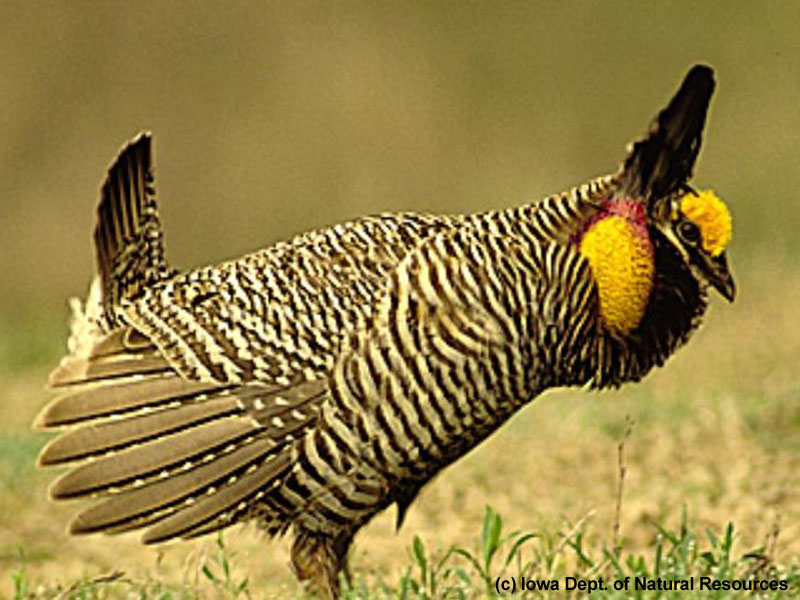 Augmentation by genetically different individuals from elsewhere in the range
clearly ameliorated detrimental effects of inbreeding in Greater Prairie-Chickens in Illinois.
Whether inbreeding is often a factor in conservation remains controversial.
Augmentation by genetically different individuals from elsewhere in the range
clearly ameliorated detrimental effects of inbreeding in Greater Prairie-Chickens in Illinois.
Whether inbreeding is often a factor in conservation remains controversial.
Genetic load results from the fixation of slightly deleterious mutations/alleles. It will tend to be most important in species with long-term small Ne. The history of a population or species is therefore critical in assessing the kinds of potential genetic problems that may afflict threatened species -- history greatly influences trajectory. Long-term small population size will lead to low risk of inbreeding depression but high genetic load. Large populations at mutation-drift equilibrium will have low genetic load but be susceptible to inbreeding depression. Island populations derived from a very few founders will have very different genetic histories (and therefore genetic susceptibilities) from large, ancient mainland populations, even for reasonably closely related species.
Selective neutrality. Selection "sees" variants against a backdrop of the effects of drift and mutation. A slightly counterintuitive result is that a deleterious or advantageous allele can be selectively neutral if its effect (know as the selection coefficient) is < 1 / (2Ne). In a sufficiently small population even a very deleterious or adaptive allele can be selectively neutral! This means that it may be very hard to get rid of deleterious alleles. Eliminating a problem caused by a recessive allele in California Condors (Gymnogyps californianus) would require excluding over half the breeding stock from the captive breeding program (Hedrick, 2001, Ralls et al., 2000). It also means, though, that even selectively advantageous alleles may be lost in small populations, due to drift. Hedrick (2001) discusses several aspects of neutral vs. adaptive or detrimental variation in the context of conservation. Chapter 3 of the Gillespie (1998) text provides useful background on the population genetics of natural selection. See also Endler (1986) or texts by Nei, Li or others.
Mating systems can interact with genetic diversity in unusual ways
We tend to think of sexual selection as working to bottleneck genes through a few males (or in some cases females). Bighorn sheep, however, may provide a counterexample in which the mating system provides its own "counterforce" to bottlenecking through a few dominant rams (J.T. Hogg, Craighead Wildlife Foundation, Missoula, MT, pers. comm.). It appears that intermediate rank males in many populations, faced with low prospects of current success "at home", may move temporarily to other populations during the breeding season. Those that are successful apparently constitute the main source of gene flow that prevents populations from becoming highly inbred. The system only works, of course, if populations are sufficiently close to one another that this sort of stepping stone gene flow is feasible.
Rare does not mean depauperate. Depauperate does not mean bottlenecked.
We tend to assume that rare species
lack genetic variability, and as a corollary that species with very low
variability must have passed through a severe population bottleneck. Several
intriguing examples suggest that it can be dangerous to make such sweeping
generalizations. Polygonella is a genus of plants with several endemic
species in Florida sand pine scrub habitats. One species in the genus is
found across most of the rest of the continental U.S. Nevertheless, the
rare scrub species are highly variable genetically, while the single widespread
species has low, uniform variability across its entire range (Lewis, 1991).
The reason, presumably, is that the scrub species, while rare, are ancient
and have never been extremely rare, at least until recently. The widespread
species, however, probably represents a very recent "escape" from a small
founder population. Similarly, the rare ancestors of several important
crop species sometimes contain far more genetic variability than the relatively
few agricultural strains. The ancestral variation may be invaluable as
a reservoir of genetic resources for coping with environmental stresses
that could decimate developed strains.
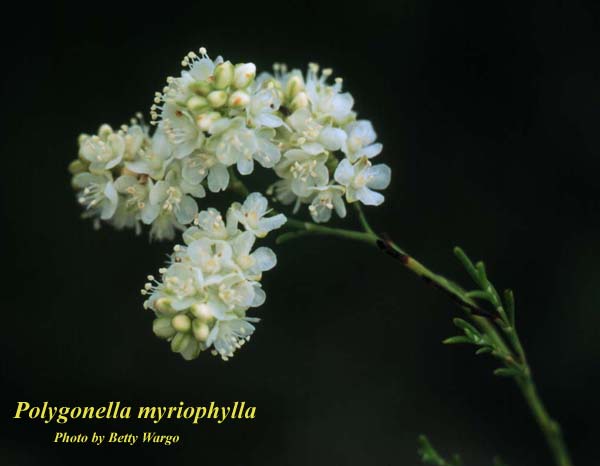 One of the Polygonella from peninsular Florida. The widespread congener, P. americana, has very
low genetic variability, despite having a much wider range than the narrow-range endemic species found in Florida.
One of the Polygonella from peninsular Florida. The widespread congener, P. americana, has very
low genetic variability, despite having a much wider range than the narrow-range endemic species found in Florida.
Amos (1999) shows that several severely bottlenecked populations such as European badgers and Antarctic fur seals retained high levels of genetic diversity. Further, the very low genetic diversity in some species, such as the northern elephant seal, is unlikely to be explained by population bottlenecks, as some have claimed (Hoelzel et al. 1993). Conversely, Briscoe et al. (1992) provided evidence of loss genetic variation in captive Drosophila despite large population sizes. Take-home message: population size is not the only consideration in the genetic (or demographic) resilience of a population.
Genetic detective work with management/conservation implications
Studies of mtDNA in sea turtles (e.g., Bowen et al.,
1992) constituted a giant advance in knowledge concerning patterns of nesting
and dispersal. The demonstration of distinct mtDNA lineages associated
with matrilineal nesting beaches provided an important conservation incentive
to protecting all existing turtle beaches. Given high site fidelity, recolonization
may not occur over the sorts of time spans that conservationists would
like in working for sea turtle recovery. In addition, it is possible that
the high site fidelity could mean that carefully designed and monitored
transplants of eggs to new beaches could establish new populations. Such
insights would arguably have taken many more years of tagging work to document
thoroughly. Genetic analyses were able to verify a long-held suspicion
fairly quickly and at a global scale. A cautionary note is that such mtDNA
conclusions do not give the full picture (because of the matrilineal inheritance). Nuclear markers applied to sea
turtles have shown considerable gene flow through males, most of which
likely occurs by matings during migration (FitzSimmons et al., 1997).
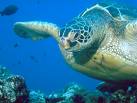 Green turtle females show high site fidelity to the beach on which they hatched.
Brian Bowen and colleagues used mtDNA to show that matrilines have high site fidelity. Nuclear DNA shows that considerable gene flow occurs via males.
Green turtle females show high site fidelity to the beach on which they hatched.
Brian Bowen and colleagues used mtDNA to show that matrilines have high site fidelity. Nuclear DNA shows that considerable gene flow occurs via males.
Similarly,
an mtDNA study of brown bears in Alaska (Talbot and Shields, 1996), argued
for greater similarity between polar bears and island brown bears, than
between mainland and island brown bears (meaning that "brown bear" would be a paraphyletic taxon that failed to include an ancestor and all its descendants, because some brown bears appeared to be more closely related to polar bears than to other brown bears). A subsequent nuclear DNA (microsatellite) study
by Paetkau et al. (1998) showed that appreciable gene flow occurred through
male dispersal and that the mtDNA conclusion of "paraphyly" in brown bears was
an overly hasty "females-only" view.
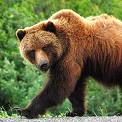
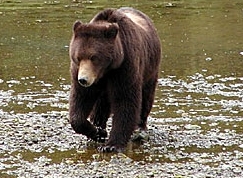
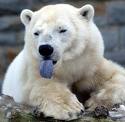 Match the bears. Although mtDNA analyses suggested that brown bears on the islands of SE Alaska (center) were more similar to polar bears (right) than they were to bears on the adjacent mainland (left), nuclear DNA showed conclusively that extensive gene flow occurs through males, for whom the ocean channels are not the barrier to dispersal that they evidently are for females. Using a single marker, especially a uniparentally inherited marker like mtDNA, can sometimes result in misleading conclusions.
Match the bears. Although mtDNA analyses suggested that brown bears on the islands of SE Alaska (center) were more similar to polar bears (right) than they were to bears on the adjacent mainland (left), nuclear DNA showed conclusively that extensive gene flow occurs through males, for whom the ocean channels are not the barrier to dispersal that they evidently are for females. Using a single marker, especially a uniparentally inherited marker like mtDNA, can sometimes result in misleading conclusions.
Stock identification and management, captive breeding
Particularly in the case of some fisheries systems,
genetics may be a useful tool for assessing the consequences of introductions,
transplants, stocking and harvest. Genetic analyses, for example, may be
the most rapid and cost effective way to assess rainbow trout introgression
into native cutthroat populations in Wyoming. [See also the discussion
in the Avise text of "shallow" vs. "deep" stock structures (p. 380)].
The most important tool for management
of captive breeding stocks is the minimization of mean kinship (Ballou
and Lacy, 1995; Caballero and Toro, 2000). Various software programs
exist for calculating mean kinship and designating pairings. Interestingly,
equal representation of parents (equal litter sizes, at least as used fro
breeding stock) is one way in which Ne can be greater
than the census population size (see the Ne lecture).
Captive breeding schemes that focus on particular genes (e.g., the MHC
-- Hughes 1991) are likely to have disastrous consequences for the genome
as a whole (Gilpin and Wills, 1991; Miller and Hedrick, 1991; Vriejenhoek
and Leberg, 1991). [See also the California Condor example noted
under Selective neutrality, above].
Using genetics to delineate taxa worthy of conservation attention
Genetics may sometimes be very useful in setting conservation priorities, or at least in highlighting patterns and issues. Examples include "species" that may not deserve that status (e.g., the Dusky Seaside Sparrow discussed in Avise, 1994). Another example is the case of the red wolf (also discussed in the Avise text) and the Mexican wolf. Whereas the red wolf is almost certainly a hybrid (and largely coyote-derived), the Mexican wolf is both a "pure" wolf and is genetically quite distinct from other extant wolf populations (Roy et al., 1994; Garcia-Moreno et al., 1996). Given an either/or choice between saving red wolves and Mexican wolves my own vote would be for the Mexican wolf. Obviously, though, politics will enter in via political boundaries, stakeholders and the economic costs involved.
In many situations, genetics may be the best or only way to decide conclusively whether a candidate taxon is worthy of special protection under the Endangered Species Act or other legislative or organizational protection. We probably can�t afford to protect every possible candidate "species" � see Avise�s pocket gopher example. By providing evidence of the degree of genetic distinctiveness, genetics may help in making difficult choices based on scanty resources. See Quattro et al. (1997) for a fish example and Johnson et al. (2005) for an example with birds.
Using genetics to assess "information content" and biogeographic/biodiversity hotspots.
Various authors have pointed to the use of genetics as a way of monitoring the "information content" of biodiversity (e.g., Crozier, 1997). Crozier�s basic thesis is that a utilitarian (as opposed to moral or esthetic) basis for preserving species lies in their potential information content (most notably in coding genes that might conceivably be directly important to humans). An objective basis for comparing the information content of sets of taxa lies in various measures that evaluate the "phylogenetic diversity" of those sets. The approach of Faith (in Forey et al.�s 1994 book, which contains other papers on the topic) is to sum the branch lengths, with high priority given to the sets with the longest total branch lengths. Petit et al. (1997) note that conservation priorities need to consider uniqueness as well as diversity -- they suggest that a measure of "allelic richness" analyzed by rarefaction techniques, provides an unbiased estimate of diversity and uniqueness across different sample sizes and taxa. Taken to an extreme, this logic would concentrate on organisms other than plants and animals, since they make up most of the branches of the evolutionary tree of life (see Fig. 11.1).
Fig. 11.1. Most of the diversity in the tree of life consists of organisms other than plants and animals.
To my mind one of the most exciting applications of conservation genetics lies in delineating major biogeographic zones that are centers of endemism. For example, various studies of the genetics of bird species on the slopes of the Andes in southwestern Colombia, Ecuador, Bolivia and Peru have pointed to areas that are particularly rich in endemic species (e.g., Brumfield and Capparella, 1996). More than one-eighth (approx. 1,200 spp.) of all the world�s bird species (approx. 8,500 spp.) occur in this region. Studies of the phylogeny and population genetic structure of a few well-chosen genera and families may therefore point to patterns of differentiation that can be extrapolated to protect a maximal number of species. Protecting charismatic birds will also serve to protect ecosystems in which one square kilometer of forest can contain more plant species than are found in all of North America.
Hybridization as a conservation problem.
Fairly recently, conservationists have realized that a new form of anthropogenic extinction may be a risk -- extinction by hybridization (Rhymer and Simberloff, 1996). The grey duck (Anas superciliosus) of New Zealand almost certainly no longer exists in pure form -- hybridization with mallards (A. platyrhynchos) has caused almost complete admixture (Rhymer et al., 1994). Among vertebrates, fish are probably most likely to suffer extensive losses in this way. In the mountain west region, most forms of cutthroat trout (e.g., the Yellowstone cutthroat trout, Oncorhynchus clarki bouvieri) are threatened by hybridization with rainbow trout (O. c. mykiss). Pure populations of cutthroat trout are now usually relegated to upper headwaters. In cases where no pure populations remain, as is the case with the red wolf, difficult conservation issues arise (Wilson et al., 2000). Are these hybrid forms worthy of protection as the last remaining legacy of the ancestral forms, or should we concentrate on other "pure" forms? Allendorf et al. (2001) provide examples from controversies surrounding the red wolf controversy and pallid and shovelnose sturgeon. They also discuss the problem of detecting "pure" populations. Simply showing that a single marker (phenotypic or molecular) does not show foreign alleles is insufficient. Even moderately high levels of admixture will be difficult to detect. In a hybrid swarm where the mean level of admixture from the non-native species is 10% 66% of individuals will appear to be pure natives if assessment is over two loci (Allendorf et al. 2001, p. 621, col. 1). Furthermore, even small amounts of introgression from closely related forms (conspecifics) can have large effects on the frequency of locally adapted gene complexes (Allendorf et al., 2001, Box 3). My lecture on muttsuckers, earlier in the course, is a local example of the conservation impacts of hybridization between native and introduced fishes in Wyoming (McDonald et al., 2008).
[And I still think that "conservation genetics" too often veers close to being an oxymoron].
Literature cited: bold red font means books or key references
Allendorf, F.W. and G. Luikart. 2007. Conservation and the Genetics of Populations. Blackwell Publishing.
Allendorf, F.W., R.F. Leary, P. Spruell, and J.K. Wenburg. 2001. The problems with hybrids: setting conservation guidelines. Trends Ecol. Evol. 16: 613-6622.
Amos, W. 1999. Two problems with the measurement of genetic diversity and genetic distance. . Pp. 75-100 In Genetics and the Extinction of Species (L.F. Landweber, and A.P. Dobson, eds.). Princeton Univ. Press, Princeton.
Amos, W., and A. Balmford. 2001. When does conservation genetics matter? Heredity 87: 257-265.
Avise, J. C. 1989. A role for molecular genetics in the recognition and conservation of endangered species. TREE 4: 279-281.
Avise, J.C. 1994. Chapter 9: Conservation Genetics. In Molecular Markers, Natural History and Evolution. Chapman and Hall, New York.
Avise, J. C., and J.L. Hamrick (eds.). 1996. Conservation Genetics: Case Histories from Nature. Chapman & Hall, NY.
Ballou, J.D. 1997. Ancestral inbreeding only minimally affects inbreeding depression in mammalian populations. J. Heredity 88: 169-178.
Ballou, J.D., and R.C. Lacy. 1995. Identifying genetically important individuals for management of genetic variation in pedigreed populations. Pp. 76-111 In Management for Survival and Recovery (J.D. Ballou, M. Gilpin, and T.J. Foose, eds.). Columbia University Press, New York.
Bouzat, J.L., H.H. Cheng, H.A. Lewin, R.L. Westemeier, J.D. Brawn, and K.N. Paige. 1998. Genetic evaluation of a demographic bottleneck in the greater prairie chicken. Conserv. Biol. 12: 836-843.
Bowen, B.S. 1999. Preserving genes, species, or ecosystems? Healing the fractured foundations of conservation policy. Mol. Ecol. 8: S5-S10.
Bowen, B.W., AB. Meylan, J.P. Ross, C.J. Limpus, G.H. Balazs, and J.C. Avise. 1992. Global population structure and natural history of the green turtle (Chelonia mydas) in terms of matriarchal phylogeny. Evol. 46: 865-881.
Briscoe, D.A., J.M. Malpica, A. Robertson, G.J. Smith, R. Frankham, R.G. Banks and J.S.F. Barker. 1992. Rapid loss of genetic variation in large captive populations of Drosophila flies: implications for the genetic management of captive populations. Conservation Biology 6: 416-425.
Brooks, D.R., R.L. Mayden, and D.A. McLennan. 1992. Phylogeny and biodiversity: conserving our evolutionary legacy. Trends Ecol. Evol. 7: 55-59.
Brumfield, R.T., and A.P. Capparella. 1996. Historical diversification of birds in northwestern South America: a molecular perspective on the role of vicariant events. Evol. 50: 1607-1624.
Caballero, A., and M.A. Toro. 2000. Interrelations between effective population size and other pedigree tools for the management of conserved populations. Genet. Res. 75: 331-343.
Caro, T.M., and M.K. Laurenson. 1994. Ecological and genetic factors in conservation: a cautionary tale. Science 263: 485-486.
Caughley, Graeme. 1994. Directions in conservation biology. J. Anim. Ecol. 63: 215-244.
Crozier, R.H. 1997. Preserving the information content of species: genetic diversity, phylogeny, and conservation worth. Ann. Rev. Ecol. Syst. 28: 243-268.
Ellstrand, N. C. and D. R. Elam. 1993. Population genetic consequences of small population size - implications for plant conservation. Ann. Rev Ecol Syst 24: 217-242.
Endler, J.A. 1986. Natural Selection in the Wild. Princeton University Press, Princeton.
Falk, D.A., and K.E. Holsinger, eds. 1991. Genetics and Conservation of Rare Plants. Oxford University Press, New York.
FitzSimmons, N.N., C.J. Limpus, J.A. Norman, A.R. Goldizen, J.D. Miller, and C. Moritz. 1997. Philopatry of male marine turtles inferred from mitochondrial DNA markers. PNAS USA 94: 8912-8917.
Forey, P.I., C.J. Humphries, and R.I. Vane-Wright (eds.). 1994. Systematics and Conservation Evaluation. Clarendon Press, Oxford.
Frankham, R. 1995. Conservation genetics. Annual Review of Genetics 29: 305-327.
Garcia-Moreno, J., M.D. Matocq, M.S. Roy, E. Geffen, and R.K. Wayne. 1996. Relationships and genetic purity of the endangered Mexican wolf based on analysis of microsatellite loci. Conservation Biology 10: 376-389
Gilligan, D.M., L.M. Woodworth, M.E. Montgomery, D.A. Briscoe, and R. Frankham. 1997. Is mutation accumulation a threat to the survival of endangered populations? Conservation Biology 11: 1235-1241.
Gilpin, M., and C. Wills. 1991. MHC and captive breeding: a rebuttal. Conserv. Biol. 5: 554-555.
Haig, S.M. 1998. Molecular contributions to conservation. Ecol. 79: 413-425.
Hartl, D.L., and A.G. Clark. 1989. Principles of Population Genetics. Sinauer Associates, Sunderland, MA.
Harvey, P.H., and H. Steers. 1999. One use of phylogenies for conservation biologists: inferring population history from gene sequences. Pp. 101-120 In Genetics and the Extinction of Species (L.F. Landweber, and A.P. Dobson, eds.). Princeton Univ. Press, Princeton.
Hedrick, P.W. 1996. Conservation genetics and molecular techniques: a perspective. Pp. 459-477 In Molecular Genetic Approaches to Conservation (T.B. Smith, and R.K. Wayne, eds.). Oxford Univ. Press, NY.
Hedrick, P.W. 2001. Conservation genetics: where are we now? Trends Ecol. Evol. 16: 629-636.
Hedrick, P. W. 2005 "Genetic restoration": a more comprehensive perspective than "genetic rescue". Trends Ecol. Evol. 20: 109.
Hedrick, P.W., and S.T. Kalinowski. 2000. Inbreeding depression in conservation biology. Ann. Rev. Ecol. Syst. 31: 139-162.
Hedrick, P.W., and P.S. Miller. 1992. Conservation genetics: techniques and fundamentals. Ecol. Applic. 2: 30-46.
Hedrick, P.W., R.C. Lacy, F.W. Allendorf, and ME. Soulé. 1996. Directions in conservation biology: comments on Caughley. Conserv. Biol. 5: 1312-1320.
Hoelzel, A.R., J. Halley, S.J. O�Brien, C. Campagna, T. Arnbom, B LeBoeuf, K. Ralls, and G.A. Dover. 1993. Elephant seal genetic variation and the use of simulation models to investigate historical population bottlenecks. J. Hered. 84: 443-449.
Holsinger, K.E. 1996. The scope and the limits of conservation genetics. Evol. 50: 2558-2561.
Hudson, R.R. 1990. Gene genealogies and the coalescent process. Oxford Surv. Evol Biol. 7: 1-44.
Hughes, A.L. 1991. MHC polymorphism and the design of captive breeding programs. Conservation Biology 5: 249-251.
Johnson, J.A., R.T. Watson, and D.P. Mindell. 2005. Prioritizing species conservation: does the Cape Verde kite exist? Proc. Royal Soc. London B 272: 1365–1371.
Kieser, J.A. 1991. Fluctuating odontometric asymmetry, morphological variability, and genetic monomorphism in the cheetah Acinonyx jubatus. Evolution 45: 1175-1183.
King, T.L., and T. Burke. 1999. Special issue on gene conservation: identification and management of genetic diversity. Mol. Ecol. 8: S1-S3.
Lacy, R.C., G. Alaks, and A. Walsh. 1996. Hierarchical analysis of inbreeding depression in Peromyscus polionotus. Evolution 50: 2187-2200. * See correction of some ## in Vol. 51: 1025
Lande, R. 1988. Genetics and demography in biological conservation. Science 241: 1455-1460.
Lande, R. 1995. Mutation and conservation. Conservation Biology 9: 782-791.
Lande, R. 1999. Extinction risks from anthropogenic, ecological and genetic factors. Pp. 1-22 In Genetics and the Extinction of Species (L.F. Landweber, and A.P. Dobson, eds.). Princeton Univ. Press, Princeton.
Landweber, L.F., and A.P. Dobson. 1999. Genetics and the Extinction of Species. Princeton Univ. Press, Princeton.
Laurenson, M.K., T.M. Caro, P. Gros, and N. Wielebnowski. 1995. Controversial cheetahs. Nature 377: 392.
Lewis, P. O. 1991. Allozyme variation in the rare Gulf Coast endemic Polygonella macrophylla Small (Polygonaceae). Plant Species Biol. 6: 1-10.
Lynch, M. 1996. A quantitative-genetic perspective on conservation issues. Pp. 471-501 In Conservation Genetics: Case Histories from Nature (J.C. Avise and J.L. Hamrick, eds.). Chapman & Hall, NY.
Lynch, M. J. Conery, and R. Burger. 1995. Mutational meltdowns in sexual populations. Evol. 49: 1067-1080.
May, R.M. 1995. The cheetah controversy. Nature 374: 309-310.
McDonald, D.B., T.L. Parchman, M.R. Bower, W.A. Hubert, and F.J. Rahel. 2008. An introduced and a native vertebrate hybridize to form a genetic bridge to a second native species. Proc. Natl. Acad. Sci. USA 105: 10842-10847.
Mech, S. G., and J. G. Hallett. 2001. Evaluating the effectiveness of corridors: a genetic approach. Conservation Biology 15:467-474.
Merola, M. 1994. Reassessment of homozygosity and the case for inbreeding depression in the cheetah, Acinonyx jubatus, implications for conservation. Conserv. Biol. 8: 961-971.
Miller, P.S., and P.W. Hedrick. 1991. MHC polymorphism and the design of captive breeding programs: Simple solutions are not the answer. Conserv. Biol. 5: 556-558.
Milligan, B.G., J. Leebens-Mack, and A.E. Strand. 1994. Conservation genetics beyond the maintenance of marker diversity. Mol. Ecol. 3: 423-435.
Mills, L.S., and F.W. Allendorf. 1996. The one-migrant-per-generation rule in conservation and management. Conservation Biology 10:1509-1518.
Moritz, C. 1994. Defining "evolutionary significant units" for conservation. Trends Ecol. Evol. 9: 373-375.
Nunney, L., and K.A. Campbell. 1993. Assessing minimum viable population size: demography meets population genetics. TREE 8: 234-239.
O'Brien, S.J., and J.F. Evermann. 1998. Interactive influence of infectious disease and genetic diversity in natural populations. TREE 3: 254-259.
O'Brien, S.J., M.E. Roelke, L. Marker, A. Newman, C.A. Winkler, D. Meltzer, L. Colly, J.F. Evermann, M. Bush, and D.E. Wildt. 1985. Genetic basis for species vulnerability in the cheetah. Science 227: 1428-1434. �
O�Brien, S.J., D.E. Wildt, D. Goldman, C.R. Merrill, and M. Bush. 1983. The cheetah is depauperate in genetic variation. Science 221: 459-462.
Paetkau, D., G.F. Shields, and C. Strobeck-C. 1998. Gene flow between insular, coastal and interior populations of brown bears in Alaska. Mol. Ecol. 7: 1283-1292.
Pearman, P.B. 2001. Conservation value of independently evolving units: Sacred cow or testable hypothesis? Conservation Biology 15:780-783.
Petit, R.J., A. ElMousadik, and O. Pons. 1997. Identifying populations for conservation on the basis of genetic markers. Conserv. Biol. 12: 844-855.
Quattro, J.M., P.L. Leberg, M.E. Douglas, and R.C. Vrijenhoek. 1996. Molecular evidence for a unique evolutionary lineage of endangered Sonoran desert fish (genus Poeciliops). Conservation Biology 10: 128-135.
Ralls, K.M., and R. Meadows. 1993. Breeding like flies. Nature 361: 689-690.
Ralls et al. 2000. Genetic management of chondrodystrophy in California condors. Anim. Conserv. 3: 145-153.
Randi, E., and V. Lucchini. 2002.Detecting rare introgression of domestic dog genes into wild wolf (Canis lupus) populations by Bayesian admixture analyses of microsatellite variation. Conservation Genetics 3: 31-45
Rhymer, J.M., D. Simberloff. 1996. Extinction by hybridization and introgression. Ann. Rev. Ecol. Syst. 27: 83-109.
Rhymer, J.M., M.J. Williams, and M.J. Braun. 1994. Mitochondrial analysis of gene flow between New Zealand mallards (Anas platyrhynchos) and grey ducks (A. superciliosus). Auk 111: 970-978.
Roy, M.S., E. Geffen, D. Smith, E.A. Ostrander, and R.K. Wayne. 1994. Patterns of differentiation and hybridization in North American wolflike canids, revealed by analysis of microsatellite loci. Mol. Biol. Evol. 11: 553-570.
Schonewald-Cox, C.M., S.M. Chambers, B. MacBryde, and L. Thomas (eds.). 1983. Genetics and Conservation. Benjamin/Cummings, Menlo Park, Calif.
Schwartz, M.K., G. Luikart, and R.S. Waples. 2006. Genetic monitoring as a promising tool for conservation and management. Trends Ecol. Evol. 22: 25-33.
Soulé, M.E., and L.S. Mills. 1998. Population genetics: no need to isolate genetics. Science 282: 1658-1659.
Spielman, D., B. W. Brook, and R. Frankham. 2004. Most species are not driven to extinction before genetic factors impact them. Proc. Natl Acad. Sci. USA 101:15261-15264.
Talbot, S.L., and G.F. Shields. 1996. Phylogeography of brown bears (Ursus arctos) of Alaska and paraphyly within the Ursidae. Molecular Phylogen. Evol. 5: 477-494.
Taylor, B.L., and A.E. Dizon. 1999. First policy then science: why a management unit based solely on genetic criteria cannot work. Mol. Ecol. 8: S11-S16.
Templeton, A.R. 2002. The Speke's Gazelle breeding program as an illustration of the importance of multilocus genetic diversity in conservation biology: response to Kalinowski et al. Conserv. Biol. 16: 1151
Vrijenhoek, R.C., and P.L. Leberg. 1991. Let's not throw the baby out with the bathwater: a comment on management for MHC diversity in captive populations. Conserv. Biol. 5: 252-254.
Vernesi, C., M.W. Bruford, G. Bertorelle, E. Pecchioli, A. Rizzoli, and H.C. Hauffe. 2008. Where's the conservation in conservation genetics? Conserv. Biol. 22: 802-804.
Vucetich, J.A., and T.A. Waite. 1998. Erosion of heterozygosity in fluctuating populations. Conserv. Biol. 13: 860-868.
Waples, R.S. 1995. Evolutionarily significant units and the conservation of biological diversity under the Endangered Species Act. Am. Fish. Soc. Symposium 17: 8-27.
Westemeier et al. 1998. Tracking the long-term decline and recovery of an isolated population. Science 282: 1695-1698.
Wilson, P.J. et al. 2000. DNA profiles of the eastern Canadian wolf and the red wolf provide evidence for a common evolutionary history independent of the gray wolf. Can. J. Zool. 78: 2156-2166.
______________________________________________________________________________________________________